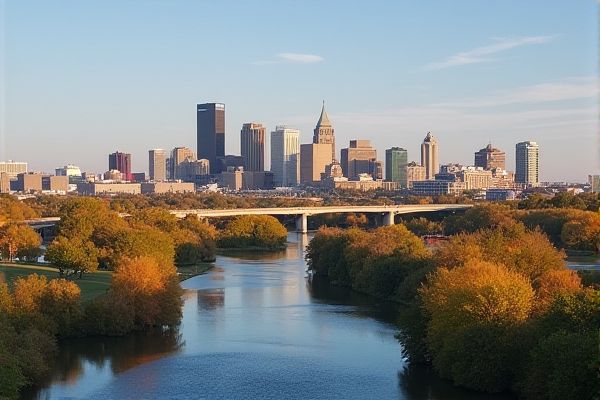
Transportation and commuting in South Dakota: Limited public transportation options statewide. Most residents rely on personal vehicles. Interstate highways: I-90 and I-29. Regional bus services available. Carpooling and vanpooling encouraged. Winters demand vehicle winterization. Cycling infrastructure developing in cities. Sioux Falls Transit: city bus service. No commuter rail service. Rideshare apps: limited availability.
Limited public transportation options statewide.
South Dakota's public transportation options are limited, particularly in rural areas, though the state's intercity bus network, including services by Jefferson Lines and rural feeder systems, covers a significant portion of the population, with 67% within 10 miles and 85% within 25 miles of an intercity bus stop. However, some areas, such as the Pine Ridge and Rosebud Reservations, and cities like Yankton and Madison, remain underserved. For more detailed insights into this issue, you can refer to the SDDOT Intercity Bus Final Report, which provides a comprehensive overview of the current infrastructure and potential improvements.
Most residents rely on personal vehicles.
In South Dakota, the majority of residents rely on personal vehicles for commuting, with 81.1% of workers driving alone to work, and only 0.2% using public transportation, highlighting the dominance of personal vehicle use in the state's transportation landscape. For more detailed information and statistics, you can visit the official South Dakota Transportation Statistics website. This data underscores the crucial role of personal vehicles in the daily lives of South Dakotans, shaping both the infrastructure and commuting habits within the state.
Interstate highways: I-90 and I-29.
In South Dakota, Interstate 29 runs along the eastern side of the state, spanning 252.5 miles from the Iowa border near Sioux City to the North Dakota border near New Effington, passing through key cities like Sioux Falls. Interstate 29 provides an essential north-south corridor, facilitating transportation and commerce across this region. Meanwhile, Interstate 90 traverses the state from east to west, offering a critical east-west route that complements the north-south transit offered by Interstate 29.
Regional bus services available.
In South Dakota, regional bus services are predominantly provided by agencies such as River Cities Public Transit, People's Transit, and Aberdeen Ride Line, which act as feeder services to the main intercity routes operated by Jefferson Lines. These services cover a wide area, including rural communities, and offer transportation for various needs such as medical appointments, shopping, employment, and education, ensuring broad coverage across the state.
Carpooling and vanpooling encouraged.
In South Dakota, carpooling and vanpooling are encouraged as part of broader shared mobility initiatives. Programs like those managed by the Office of Fleet and Travel Management and local transit services promote shared transportation to reduce costs, traffic congestion, and environmental impact. Although the Statewide Coordinated Transportation Plan does not specifically detail vanpooling programs in this context, the emphasis on shared mobility highlights its significance in achieving sustainable transportation solutions.
Winters demand vehicle winterization.
In South Dakota, winters require thorough vehicle winterization, including professional checks on brakes, battery, tires, and fluids. Additionally, equipping vehicles with essential supplies such as shovels, jumper cables, and emergency kits is crucial to handle harsh road conditions and potential strandings. For comprehensive guidance on preparing for winter conditions, visit the South Dakota Winter Driving Tips page. This preparation ensures safety and readiness, allowing drivers to navigate the challenges of winter with greater confidence.
Cycling infrastructure developing in cities.
In Vermillion, South Dakota, the city is developing a robust cycling infrastructure through its Bicycle Master Plan, which includes establishing shared bike routes, adapting local streets for bicycle travel, and enhancing the trail system to link neighborhoods and major destinations, promoting a safe and convenient Cycling Environment.
Sioux Falls Transit: city bus service.
Sioux Falls' city bus service, operated by Sioux Area Metro (SAM), offers fast and frequent public transit routes, including bus and on-demand rides. The service includes multiple color-coded routes with real-time service alerts and updates, ensuring convenient and efficient commuting within the city.
No commuter rail service.
South Dakota stands as the only state in the contiguous United States without passenger rail service, largely due to significant hurdles such as high costs and a low population density. These challenges have been addressed by state officials, who continue to express skepticism about the feasibility of establishing such a service. To learn more about this topic, visit the article on South Dakota Searchlight. Despite the potential benefits, the economic and demographic realities make it a formidable task to bring passenger rail to this region. As discussions persist, the state remains cautious about moving forward with what would be a significant transportation endeavor.
Rideshare apps: limited availability.
Rideshare apps like Uber and Lyft are available in Sioux Falls, South Dakota, but their availability and service areas may be limited compared to larger cities. This can affect specific services such as airport car service and local ride-sharing options. To learn more about how these services operate in Sioux Falls, you can visit the Uber Website for detailed information.
